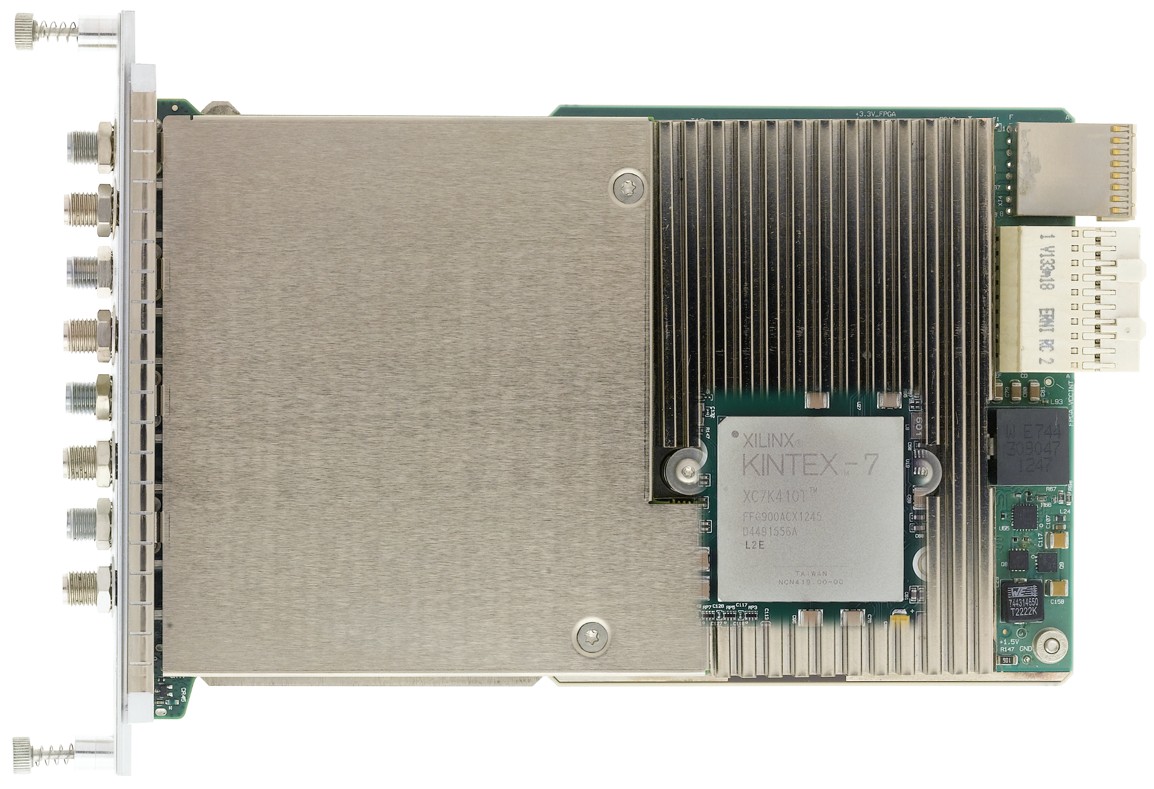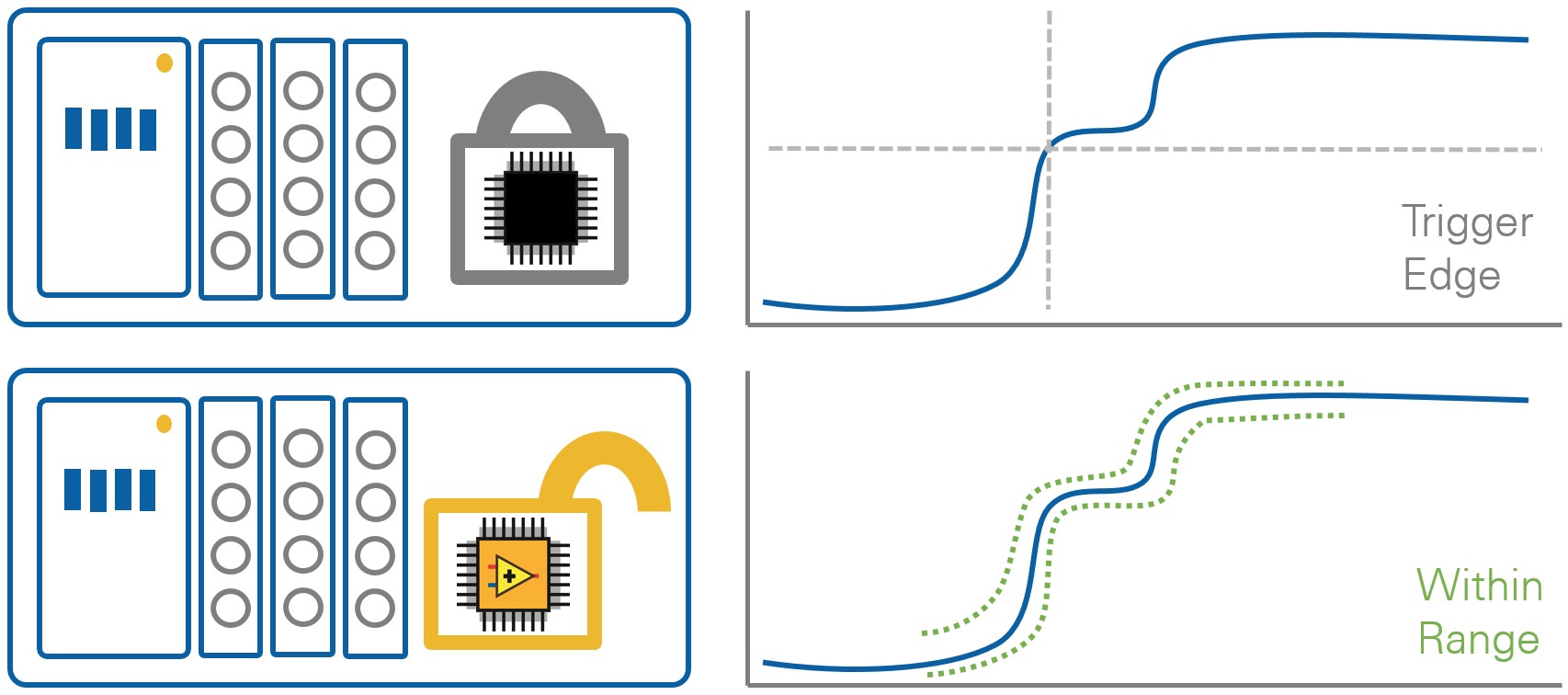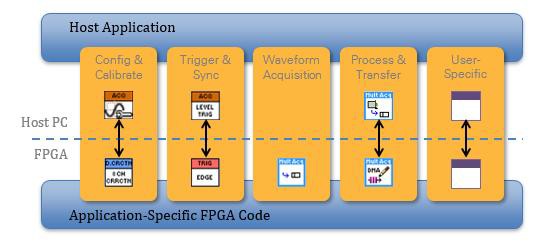Get Better Measurements Faster Using Oscilloscopes With User-Programmable FPGAs
Overview
Oscilloscope requirements are increasing quickly and new research and test applications employ a growing number of faster and more complex signals. This requires more intelligent test equipment to detect certain signal conditions deterministically without dead time, to process data during acquisition to reduce test times, or to quickly generate feedback signals to control the device under test (DUT). Over the last decade, the tight integration of powerful PC software with modular I/O helped reduce test time and overall test cost. The new product category of software-designed instruments takes this concept to the next level by extending the reach of user-algorithms right into the instruments themselves. This enables the design of highly optimized measurement systems, which can analyze each sample in real time and therefore eliminate time-consuming postprocessing. This results in shorter test times and faster discoveries in science and research applications.
Contents
- What Is a Reconfigurable Oscilloscope?
- User-Programmable FPGA
- Using Software to Program the FPGA on Your Oscilloscope
- Learn More About the Reconfigurable Oscilloscopes
- Next Steps
What Is a Reconfigurable Oscilloscope?
Instruments like oscilloscopes use multiple layers of software—some more visible to the user than others. Software on a PC controls overall test system execution, instrument drivers allow communication with the oscilloscope, and software embedded on the instrument itself controls how data is acquired and provided to the user. While traditional instruments provide fixed measurement capability through an instrument driver, modular instruments make use of open PC software and the processing power of modern CPUs to execute signal analysis on the PC instead of inside the instrument. This means you can quickly customize the analysis performed on acquired data to meet your specific needs such as improved test times or higher resolution measurements.
Software-designed instruments take this concept one step further by giving you the ability to modify or even completely replace the embedded software running directly on the instrument’s FPGA. You can implement custom real-time analysis and complex triggers with no dead time (missed signals) because every acquired data point can be analyzed in real time on the instrument’s FPGA. In short, software-designed instruments give you the option to access all software layers—from the host PC down to the pins of an instrument’s data converter—to implement custom changes that meet the demands of your specific application.
NI offers a number of reconfigurable oscilloscopes that feature up to 400 MHz of analog bandwidth, eight input channels, 14 bits of measurement resolution, 1 GS/s sampling rate, and a user-programmable Xilinx Kintex-7 FPGA.
Figure 1: A user-programmable FPGA is the central component of a reconfigurable oscilloscope.
User-Programmable FPGA
Whereas off-the-shelf instrumentation hardware traditionally has fixed capability, NI is leading the way in more open, flexible measurement devices based on FPGA technology. FPGAs are high-density digital chips that you can customize to directly incorporate custom signal processing and control algorithms into measurement hardware. The result is off-the-shelf hardware that has the best of both worlds—fixed, high-quality measurement technology; the latest digital bus integration; and user-customizable logic that is highly parallel, provides low latency, and is tied directly to I/O for inline processing and tight control loops.
FPGAs continue to gain design wins and market share from application-specific standard products (ASSPs) and application-specific integrated circuits (ASICs) because they keep up with Moore’s law better than other devices and dramatically lower development costs. This results in smaller test system size and lower power consumption. Very capable FPGAs are entering the market and defining the hardware capabilities of many devices, but the IP they contain is vendor defined and the FPGA’s power may be inaccessible to you. This is largely because the specialized hardware description language (HDL) knowledge needed to program these devices requires a steep learning curve and is generally restricted to digital design experts.
LabVIEW software makes the latest FPGA technology accessible. Using graphical programming, you can implement logic to define the behavior of an instrument in hardware and reprogram the instrument when requirements change. The graphical dataflow nature of LabVIEW is well suited for implementing and visualizing the type of parallel operations that can be implemented in digital hardware.
Figure 2: A user-programmable FPGA allows you to customize the firmware of an oscilloscope to achieve the results required.
Using Software to Program the FPGA on Your Oscilloscope
Reconfigurable oscilloscopes can be programmed with several levels of flexibility. The fastest way to get a reconfigurable oscilloscope up, running, and collecting data as part of a test system is using the instrument driver. NI oscilloscopes are programmed with the NI-SCOPE instrument driver and can also be programmed with the oscilloscope IVI driver set. Instrument drivers allow you to get traditional instrument capability from an oscilloscope quickly. These drivers include the ability to configure sampling rate, record length, and vertical range among many other settings. However, an instrument driver may allow you to call only a limited set of the total features of the oscilloscope. A driver absolutely does not allow for customization of the firmware of an instrument to meet a new measurement demand.
One instance of an instrument driver limiting your ability to use the full potential of an oscilloscope is invoking trigger modes. The oscilloscope IVI driver only allows for the use of a few trigger modes: edge, level, and window. An oscilloscope may have many more triggering modes, but the instrument driver can only configure the device to use those few. You may also want a very specific set of trigger logic that is not built into an oscilloscope that is available on the market. In this case, you could use the FPGA in the data path of the oscilloscope to program a logical trigger that will operate on the hardware of the instrument.
The LabVIEW FPGA Module extends LabVIEW system design software to FPGAs on NI reconfigurable I/O (RIO) hardware such as the PXIe-5171R and PXIe-5164 oscilloscopes, high-speed serial instruments, RF vector signal analyzers, and vector signal transceivers (VSTs), which introduced the concept of software-designed instruments in 2012.
LabVIEW is an ideal tool for programming FPGAs because of its inherent parallelism and dataflow concepts, which resemble the dataflow in FPGAs. LabVIEW abstracts the processing and data movement performed on the different computing elements of a system (such as FPGAs in instruments and microprocessors in PCs) and therefore enables you to use the power of software-designed instruments without requiring extensive knowledge of FPGA programming such as Verilog or VHDL, computing architectures, or data streaming.
The Instrument Design Library is a software stack built on the LabVIEW FPGA Module and NI RIO architecture. It provides several starting points for applications including reference designs, examples, and LabVIEW sample projects. These starting points all feature default LabVIEW FPGA personalities and prebuilt FPGA bitfiles to help you get started quickly without extensive programming.
Figure 3 shows the software architecture of a software-designed instrument (in this case, a reconfigurable oscilloscope). The architecture consists of routines implemented on the FPGA for the actual acquisition and real-time processing, as well as corresponding software modules on the host PC that interact with their FPGA counterparts to configure and control the measurements, handle the data transfer across the PXI Express bus, and present the data to the user.
Figure 3: In the architecture of a software-designed instrument, host VIs interact with their counterparts on the FPGA to configure hardware and perform measurements. Download the instrument driver or the instrument design libraries for your reconfigurable oscilloscope.
Host PC components are very similar to instrument drivers; FPGA code is comparable to traditional oscilloscope firmware. In contrast to traditional oscilloscopes, you can use these components to build custom oscilloscope IP, and because they are open, you can modify and extend them to match specific needs.
Learn More About the Reconfigurable Oscilloscopes
NI offers several reconfigurable options for the PXI Oscilloscope. Oscilloscopes that have an FGPA include "Reconfigurable" in the model description on the oscilloscope category page.
Test Benefits of Oscilloscopes With User-Programmable FPGAs
One of the ultimate goals in test applications is to reduce total test cost. Time is often the main contributor to cost in high-volume manufacturing, while flexibility and reusability are important in high-mix or -maintenance test systems. Here are three examples that show how to save time and money by using oscilloscopes with user-programmable FPGAs.
Different industries, applications, and measurements require different oscilloscopes. To find out how reconfigurable oscilloscopes are reducing time to market and the cost of test, read more about each device family.


